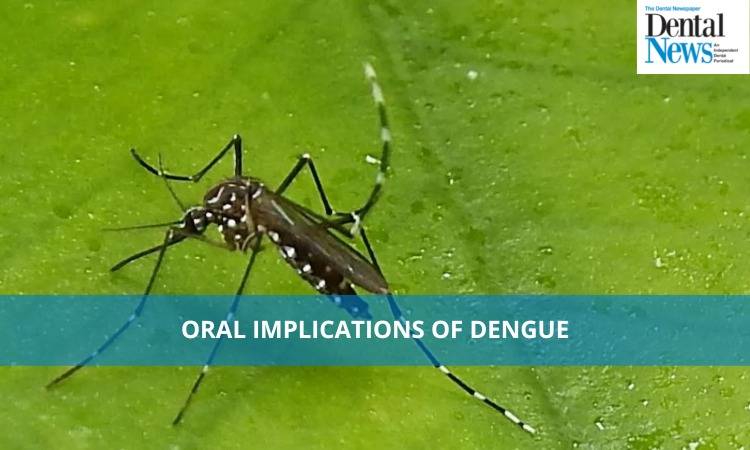
With an estimated 2.5 billion victims spread over more than 100 nations, dengue has become a serious public health issue. The doctor should ensure an early and appropriate treatment strategy by being knowledgeable of the many clinical signs of this ailment.
Dengue also referred to as "break-bone fever" because of the excruciating joint agony that makes bones physically break, is currently expanding throughout most tropical countries. Since it has become one of the most prevalent viral infections spread by mosquitoes, prevention is crucial. It is mostly brought on by the Flaviviridae virus family and spread by the Aedes Aegypti mosquito.
Oral symptoms of dengue
About 30% of individuals with dengue viral infections experience oral mucosa symptoms, more frequently in patients with Dengue haemorrhagic fever (DHF) than Dengue Fever (DF). The lips, tongue, and small vesicles on the soft palate all exhibit erythema and crusting, which are the most common oral signs of dengue viral infections. Numerous haemorrhagic bullae were observed on the left sublingual mucous membrane, the left lateral side of the tongue, and the floor of the mouth.
Along with spontaneous bleeding from the gingiva and tongue, they also reported the presence of brown colour plaques with a rough surface on the buccal mucosa that bled when touched. The tonsils on both sides were inflamed, and there were haemorrhagic plaques and bleeding gums as well.
Xerostomia and tongue coating have also been reported. The relationship between tongue coating and thrombocytopenia was statistically significant. Although oral symptoms like candidiasis are frequently linked to dengue fever, they have not been thoroughly explored. A significant risk factor, particularly for oral candidiasis, is likely to be transient immunosuppression brought on by dengue infection. There have also been reports of jaw osteonecrosis and taste alteration linked to DF.
Other Signs and Symptoms
Symptoms can appear four to six days after infection and can linger for up to ten days.
· Unexpectedly high fever
· Bad headaches
· Painful joints and muscles
· Fatigue
· Pain behind the eyes
· Nausea
· Vomiting
· A skin rash that starts to develop two to five days after the commencement of a fever
· Sporadic bleeding (such as a nose bleed, bleeding gums, or easy bruising)
Dengue Fever Diagnosis
Serology or virus isolation and reverse transcriptase polymerase chain reaction are used to confirm dengue infection. When diagnosing dengue in the lab, the timing of the clinical course is crucial. The gold standard for detecting dengue infections is virus isolation and identification. This process, which is reliable, simple, and incredibly quick, can be completed utilizing infected cell cultures collected from plasma, serum, or WBC. Additionally, it enables the identification of several viruses in individuals who are simultaneously battling illnesses of more than one serotype. Inform your doctor immediately if you are unwell after visiting a tropical region. This will enable your doctor to determine whether a dengue infection might have led to your symptoms.
Dengue Fever Prevention
Avoiding mosquito bites is the greatest approach to avoid contracting the illness, especially if you reside in or are visiting a tropical region. This entails taking precautions and working to reduce the mosquito population.
To safeguard yourself:
· Use insect repellent.
· When you're outside, dress in long sleeves and tucked-in pants.
· Use air conditioning if it's accessible indoors.
· Ensure the screens on your doors and windows are solid and without any gaps. Use mosquito netting if your sleeping spaces don't have air conditioning or a screen.
· If you get dengue symptoms, visit your doctor.
· To reduce the mosquito population, eliminate mosquito breeding sites. These could be used in flower pots, cans, or old tires that catch the rain. Pet water dishes and outdoor birdbaths should both have fresh water periodically changed.
Treatment
Ibuprofen and other non-steroidal anti-inflammatory medications should not be taken. Paracetamol is typically used to treat fever. Sponging is beneficial during the initial stages of infection, oral fluids are increased for the patients, and when dehydration is present, intravenous fluids should be delivered with follow-up hematocrit and platelet counts, which should be continued until the patient recovers.
Various statistics show that after an incubation period of 3 to 14 days, about 80% of infected individuals develop fever and flu-like symptoms. If the patient gets enough rest and drinks, these symptoms will ultimately go away. The remaining 20% of patients have a 20% chance of developing serious illnesses, including bleeding, very high fevers, rashes, vomiting, and intermittent consciousness. The mortality rate varies by nation.
Conclusion
Dengue affects hundreds of millions of individuals each year. Even though most instances of dengue are mild or even symptomless, the idea of a severe illness might be frightening. Fortunately, you can take precautions to lessen your risk of mosquito bites and watch out for severe dengue symptoms. Make sure you know where to go for emergency medical care if you fall sick while traveling. As long as you receive prompt medical attention, you will probably recover if you contract dengue and become extremely unwell.

Dr Amna Bilal
The author is a contributing writer at Dental News Pakistan and can be reached at amna0795@yahoo.com

